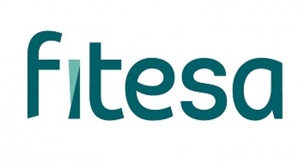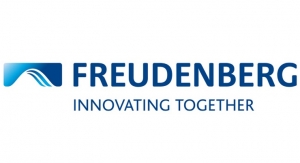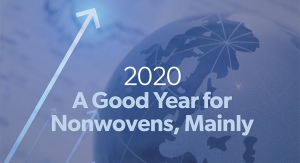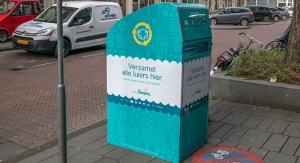09.09.14
Fitesa
Simpsonville, SC
www.fitesa.com
2014 Nonwovens Sales: $755 million
Key Personnel
Silverio Baranzano, CEO; Hal Singley, CFO
Plants
Gravatai, Brazil; Lima, Peru; San Jose Iterbide, Mexico; Simpsonville, SC; Green Bay, WI; Washougal, WA; Norrkoping, Sweden; Peine, Germany; Trezzano Rosa, Italy; Tianjin, China
Processes
Spunbond, SMS, bicomponent spunbond and SMS, meltblown, carded (chemical bonded, thermal bonded, air through bonded), airlaid, laminates
Major Markets
Hygiene, medical and industrial specialties (filtration, agricultural, sorbent)
Global sales grew nearly 10% to $755 million in 2014 for Fitesa, a leading global nonwovens producer serving the absorbent hygiene products market. Growth came from the full utilization of capacity installed in late 2012 and early 2013 as well as the startup of a new line in Simpsonville, SC, in the fourth quarter of 2014, operational efficiency improvements throughout Europe and a significant increase in sales of high tech specialty fabrics.
The past few years have been transformative for Fitesa, who partnered with Fiberweb within the hygiene business in the North and South American legs of its business in 2009 before ultimately buying out its partner’s entire hygiene-related asset base in late 2011.
As if this growth weren’t enough, the company has since announced several investments around the world.
“The integration of the Fiberweb acquisition in 2012 was aided by our experience with the integration of the FitesaFiberweb joint venture in 2009,” says director of sales and marketing Ray Dunleavy. “Fitesa did not lose a single executive in the process which was very important to achieve anticipated synergies and guarantee the continuity of the operations at all sites. Top executives participated personally in the integration, conveying Fitesa’s values and principles, respecting local cultures and being close to the “front lines” of the business. In addition, local employees had the chance to experience the Fitesa global mindset by integrating into global committees, joining projects in different regions and participating in exchange programs.”
The company now manufactures spunbond/spunmelt nonwovens, mainly for hygiene applications—in Brazil, Peru, Mexico, South Carolina, Washington, Sweden and Italy—operates a carded line in Wisconsin and a carded line and an airlaid line, acquired from Fiberweb, in Tianjin, China.
“We continue to find opportunities to grow with our hygiene customers. We also see a high level of interest in innovative fabrics that deliver benefits to hygiene product manufacturers in softness, dryness, comfort and fit and differentiation,” Dunleavy says. “One thing is common to every region: margins are tight and customers tend to be large with a lot of purchasing power requiring nonwovens manufacturers to be very cost effective.”
In October 2014, Fitesa proved its commitment to being a large, multinational company when it confirmed its global growth plan. Included in these efforts are a 20,000-ton line in Sao Paulo, Brazil, an expansion to an existing line in Lima, Peru and a new spunmelt line in Norrköping, Sweden. These latest investments are on top of other expansions Fitesa has made since acquiring the Fiberweb business including a new carded line, capable of making air through bonded and resin bonded products, in Tianjin, China and a second line in Simpsonville, SC. These efforts have increased Fitesa’s size as well as its global scale.
Fitesa’s recent investment in Brazil includes a new state-of-the-art line in Sao Paolo that meets the growing demand of hygiene manufacturers in South America. It will be housed in a brand new facility in Sao Paolo, Fitesa’s second location in Brazil.
“We select sites for investment based on the needs of our customers, the potential growth of the market and consequently that of our customers,” Dunleavy adds. “In South America the penetration of hygiene products is still increasing, despite the recent macroeconomic challenges in the region. Our customers install new converting equipment to meet those needs and we support them with capacity expansions. Brazil’s demand for spunbond/spunmelt accounts for more than 50% of the demand in South America. This plant shows a strong commitment to our customers and represents a growth in supply of about 30% from Fitesa to the South American market.”
In August, Fitesa proved it wasn’t done investing yet, announcing plans to build a third spunmelt line in San Jose Iturbide, Mexico. The line, which is scheduled to be complete in late 2016, will help serve hygiene markets in North and Central America.
“The Mexican market is very integrated with the U.S. and will enable us to localize production of spunbond/spunmelt and establish a solid platform for exports,” Dunleavy says.
Meanwhile, Fitesa’s second U.S. line, located in Simpsonville, SC, has been operational since the fourth quarter of 2014 and is responding to growth in the U.S. market.
“The U.S. disposable hygiene market continues to grow, although now primarily in adult incontinence products,” Dunleavy says. “As a result, spunbond/spunmelt demand will continue to grow.”
In European investment news, Fitesa completed work on a new spunmelt line in Sweden during the first quarter and has been supporting the needs of customers in Eastern and Western Europe, which is still growing despite its maturity. The company also operates spunmelt plants in Germany and Italy.
As it continues to invest aggressively in the Americas and Europe, Fitesa’s focus on Asia and other developed regions has not been so great. The company currently has only airlaid and carded assets in China and no operation in the Middle East, markets that have seen a great deal of interest from other spunmelt manufacturers in recent years.
Dunleavy would not speculate on Fitesa’s next investment.
“We are focused on meeting the needs of our hygiene customers, many of which do business outside our current market area. We are well aware of the rapid growth of absorbent hygiene products in developing regions,” Dunleavy concludes. “We will expand in those regions where and when we see an opportunity with our current customers or a demand that is not being met by local producers.”
Simpsonville, SC
www.fitesa.com
2014 Nonwovens Sales: $755 million
Key Personnel
Silverio Baranzano, CEO; Hal Singley, CFO
Plants
Gravatai, Brazil; Lima, Peru; San Jose Iterbide, Mexico; Simpsonville, SC; Green Bay, WI; Washougal, WA; Norrkoping, Sweden; Peine, Germany; Trezzano Rosa, Italy; Tianjin, China
Processes
Spunbond, SMS, bicomponent spunbond and SMS, meltblown, carded (chemical bonded, thermal bonded, air through bonded), airlaid, laminates
Major Markets
Hygiene, medical and industrial specialties (filtration, agricultural, sorbent)
Global sales grew nearly 10% to $755 million in 2014 for Fitesa, a leading global nonwovens producer serving the absorbent hygiene products market. Growth came from the full utilization of capacity installed in late 2012 and early 2013 as well as the startup of a new line in Simpsonville, SC, in the fourth quarter of 2014, operational efficiency improvements throughout Europe and a significant increase in sales of high tech specialty fabrics.
The past few years have been transformative for Fitesa, who partnered with Fiberweb within the hygiene business in the North and South American legs of its business in 2009 before ultimately buying out its partner’s entire hygiene-related asset base in late 2011.
As if this growth weren’t enough, the company has since announced several investments around the world.
“The integration of the Fiberweb acquisition in 2012 was aided by our experience with the integration of the FitesaFiberweb joint venture in 2009,” says director of sales and marketing Ray Dunleavy. “Fitesa did not lose a single executive in the process which was very important to achieve anticipated synergies and guarantee the continuity of the operations at all sites. Top executives participated personally in the integration, conveying Fitesa’s values and principles, respecting local cultures and being close to the “front lines” of the business. In addition, local employees had the chance to experience the Fitesa global mindset by integrating into global committees, joining projects in different regions and participating in exchange programs.”
The company now manufactures spunbond/spunmelt nonwovens, mainly for hygiene applications—in Brazil, Peru, Mexico, South Carolina, Washington, Sweden and Italy—operates a carded line in Wisconsin and a carded line and an airlaid line, acquired from Fiberweb, in Tianjin, China.
“We continue to find opportunities to grow with our hygiene customers. We also see a high level of interest in innovative fabrics that deliver benefits to hygiene product manufacturers in softness, dryness, comfort and fit and differentiation,” Dunleavy says. “One thing is common to every region: margins are tight and customers tend to be large with a lot of purchasing power requiring nonwovens manufacturers to be very cost effective.”
In October 2014, Fitesa proved its commitment to being a large, multinational company when it confirmed its global growth plan. Included in these efforts are a 20,000-ton line in Sao Paulo, Brazil, an expansion to an existing line in Lima, Peru and a new spunmelt line in Norrköping, Sweden. These latest investments are on top of other expansions Fitesa has made since acquiring the Fiberweb business including a new carded line, capable of making air through bonded and resin bonded products, in Tianjin, China and a second line in Simpsonville, SC. These efforts have increased Fitesa’s size as well as its global scale.
Fitesa’s recent investment in Brazil includes a new state-of-the-art line in Sao Paolo that meets the growing demand of hygiene manufacturers in South America. It will be housed in a brand new facility in Sao Paolo, Fitesa’s second location in Brazil.
“We select sites for investment based on the needs of our customers, the potential growth of the market and consequently that of our customers,” Dunleavy adds. “In South America the penetration of hygiene products is still increasing, despite the recent macroeconomic challenges in the region. Our customers install new converting equipment to meet those needs and we support them with capacity expansions. Brazil’s demand for spunbond/spunmelt accounts for more than 50% of the demand in South America. This plant shows a strong commitment to our customers and represents a growth in supply of about 30% from Fitesa to the South American market.”
In August, Fitesa proved it wasn’t done investing yet, announcing plans to build a third spunmelt line in San Jose Iturbide, Mexico. The line, which is scheduled to be complete in late 2016, will help serve hygiene markets in North and Central America.
“The Mexican market is very integrated with the U.S. and will enable us to localize production of spunbond/spunmelt and establish a solid platform for exports,” Dunleavy says.
Meanwhile, Fitesa’s second U.S. line, located in Simpsonville, SC, has been operational since the fourth quarter of 2014 and is responding to growth in the U.S. market.
“The U.S. disposable hygiene market continues to grow, although now primarily in adult incontinence products,” Dunleavy says. “As a result, spunbond/spunmelt demand will continue to grow.”
In European investment news, Fitesa completed work on a new spunmelt line in Sweden during the first quarter and has been supporting the needs of customers in Eastern and Western Europe, which is still growing despite its maturity. The company also operates spunmelt plants in Germany and Italy.
As it continues to invest aggressively in the Americas and Europe, Fitesa’s focus on Asia and other developed regions has not been so great. The company currently has only airlaid and carded assets in China and no operation in the Middle East, markets that have seen a great deal of interest from other spunmelt manufacturers in recent years.
Dunleavy would not speculate on Fitesa’s next investment.
“We are focused on meeting the needs of our hygiene customers, many of which do business outside our current market area. We are well aware of the rapid growth of absorbent hygiene products in developing regions,” Dunleavy concludes. “We will expand in those regions where and when we see an opportunity with our current customers or a demand that is not being met by local producers.”












